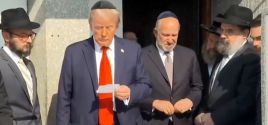Russia Denies Passing On Iraq War InfoCBS/APMar. 26, 2006 |
Popular 
Israel Detains American Journalist for Reporting on Damage from Iran's Strikes [UPDATE]

Chris Rufo Discovers Who is Flooding The Small Town of Charleroi, Pennsylvania With Haitian Migrants

WATCH: New Film 'Atrocity Inc' Exposes How Israel Lied About October 7th to Justify Genocide

Netanyahu: Trump Called to 'Congratulate' Me On War With Hezbollah

Trump Visits Lubavitcher Rebbe's Grave With Ben Shapiro for October 7th
 (CBS/AP) Calling the allegations “baseless,” Russian officials are denying that their government provided Saddam Hussein with intelligence on U.S. military movements and plans during the opening days of the war in Iraq. Those claims were made in a Pentagon report released Friday. The report does not assess the value of the information or provide details beyond citing an Iraqi document that says the battlefield intelligence was provided to Saddam through the Russian ambassador in Baghdad. U.S. officials tell CBS News none of information was of any real strategic value, and large parts of it were incorrect. U.S. officials, however, were "surprised by the Russians' actions." CBS News correspondent Bob Orr reports that military analysts think the bad information actually helped feed Saddam's delusions. Maria Zakharova, spokeswoman for Russia's U.N. mission in New York, said the allegations were false. "To my mind, from my understanding it's absolutely nonsense and it's ridiculous," she said, adding that the U.S. government had not shown Russia the evidence cited in the report. "Somebody wants to say something, and did - and there is no evidence to prove it." A Foreign Intelligence Service spokesman noted that, what he calls, ``similar, baseless accusations concerning Russia's intelligence have been made more than once.'' A duty officer in his department says the service does not believe it's ``necessary to comment on such fabrications.'' Documents released as part of a Pentagon's report show the Russian government had sources inside the American military command as it planned and executed the 2003 invasion. Whether by chance or design, one piece of Russian intelligence actually contributed to an important U.S. military deception effort. By telling Saddam that the main attack on Baghdad would not begin until the Army's 4th Infantry Division arrived around April 15, the Russians reinforced an impression that U.S. commanders were trying to create to catch the Iraqis by surprise. The attack on Baghdad began well before the 4th Infantry arrived, and Saddam's regime collapsed quickly. As originally planned by Gen. Tommy Franks, the Central Command chief who ran the war, the 4th Infantry was to attack into northern Iraq from Turkey, but the Turkish government refused to go along. Meanwhile the 4th Infantry's tanks and other equipment remained on ships in the eastern Mediterranean for weeks — a problem that Franks sought to turn into an advantage by assaulting Baghdad without them. Based on a captured Iraqi document — a memo to Saddam from his Ministry of Foreign Affairs, dated April 2 — Russian intelligence reported through its ambassador that the American forces were moving to cut off Baghdad from the south, east and north, with the heaviest concentration of troops in the Karbala area. It said the Americans had 12,000 troops in the area, along with 1,000 vehicles. In fact, Karbala was a major step on the U.S. invasion route along the Euphrates River to Baghdad. The Karbala assault was launched April 1. A key bridge over the Euphrates, near Karbala, was seized on April 2, permitting U.S. forces to approach Baghdad from the southwest before Iraq could move sufficient forces from the north. The Pentagon report also said the Russians told the Iraqis that the Americans planned to concentrate on bombing in and around Baghdad, cutting the road to Syria and Jordan and creating enough confusion to force Baghdad residents to flee. The Pentagon report, designed to help U.S. officials understand in hindsight how Saddam and his military commanders prepared for and fought the war, paints a picture of an Iraqi regime blind to the threat it faced from the U.S. invaders, hamstrung by Saddam's inept military leadership and deceived by its own propaganda. "The largest contributing factor to the complete defeat of Iraq's military forces was the continued interference by Saddam," the report said. While Saddam disastrously miscalculated, the U.S. military also erred in areas beyond the well-known failure to realize that the Baghdad regime had no weapons of mass destruction, according to the 210-page report. U.S. officials believed Iraq would set its oil wells on fire as part of a scorched-earth policy, and the invasion plan was constructed in ways meant to get U.S. troops to the southern oil wells before they could be torched. The report said, however, that while captured Iraqi documents show that there were plans made at the regional or local level to destroy the northern and southern oil wells, Saddam had expressly forbidden it. A classified version of the Pentagon report, titled "Iraqi Perspectives Project," is not being made public. |



